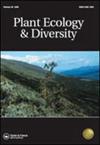降雨量和季节性的变化调节了吉娃娃沙漠一个吉普赛植物群落的分类、功能和系统发育多样性
IF 1.6
4区 生物学
Q2 PLANT SCIENCES
引用次数: 1
摘要
摘要背景气候变化预计将改变干旱区未来的降雨状况,这可能会影响吉娃娃沙漠中的吉普赛植物多样性成分。目的研究不同降雨时间和降雨量对吉普赛植物群落分类、功能和系统发育组成的影响。方法采用从吉娃娃环沙漠南部提取的土壤块体,在三个降雨时间(典型、早期和晚期)和两个降雨量(100%和50%)的温室试验中,评估其对分类、功能和系统发育多样性的影响。结果50%平均降雨量的灌溉处理降低了物种丰富度和植物丰富度,改变了物种组成。在100%灌溉条件下,典型降雨和晚降雨处理的比叶面积低于早降雨处理。在11月的后期处理中,系统发育多样性显著降低。结论我们的研究表明,缺水对植物群落的影响很大,物种丰富度和多样性降低。然而,迟雨可以缓冲水分减少的影响,但只会对吉娃娃沙漠中的吉普赛群落的分类和功能多样性产生影响,而对系统发育多样性产生相反的影响。本文章由计算机程序翻译,如有差异,请以英文原文为准。
Changes in rainfall amount and seasonality modulate taxonomic, functional, and phylogenetic diversity in a gypsophilous plant community in the Chihuahuan Desert
ABSTRACT Background Climate change is expected to alter future rainfall regime in arid zones, which may impact gypsophilous plant diversity components in the Chihuahuan Desert. Aims We investigated the effects of different rainfall timings and amounts on the taxonomic, functional, and phylogenetic components of a gypsophilous plant community. Methods We used soil monoliths extracted from the southern Chihuahuan Desert in a greenhouse experiment with three rainfall timings (typical, early, and late) and two rainfall amounts (100% and 50%) and evaluated the effects on taxonomic, functional, and phylogenetic diversity. Results Irrigation treatment with 50% of average rainfall reduced species richness and plant abundance and altered species composition. At 100% irrigation, specific leaf area was lower in the treatments with typical and late rainfall timing than in the treatment with early rainfall. Phylogenetic diversity was significantly lower in the late timing treatment in November. Conclusion Our study evidence that the water shortage impacted drastically on the plant community by decreased species richness and diversity. Nevertheless, late rainfall can buffer the effects of water diminution but only on taxonomic and functional diversity, with the opposite effect on the phylogenetic diversity, in the gypsophilous communities in the Chihuahuan Desert.
求助全文
通过发布文献求助,成功后即可免费获取论文全文。
去求助
来源期刊

Plant Ecology & Diversity
PLANT SCIENCES-
CiteScore
3.30
自引率
0.00%
发文量
26
审稿时长
3 months
期刊介绍:
Plant Ecology and Diversity is an international journal for communicating results and novel ideas in plant science, in print and on-line, six times a year. All areas of plant biology relating to ecology, evolution and diversity are of interest, including those which explicitly deal with today''s highly topical themes, such as biodiversity, conservation and global change. We consider submissions that address fundamental questions which are pertinent to contemporary plant science. Articles concerning extreme environments world-wide are particularly welcome.
Plant Ecology and Diversity considers for publication original research articles, short communications, reviews, and scientific correspondence that explore thought-provoking ideas.
To aid redressing ‘publication bias’ the journal is unique in reporting, in the form of short communications, ‘negative results’ and ‘repeat experiments’ that test ecological theories experimentally, in theoretically flawless and methodologically sound papers. Research reviews and method papers, are also encouraged.
Plant Ecology & Diversity publishes high-quality and topical research that demonstrates solid scholarship. As such, the journal does not publish purely descriptive papers. Submissions are required to focus on research topics that are broad in their scope and thus provide new insights and contribute to theory. The original research should address clear hypotheses that test theory or questions and offer new insights on topics of interest to an international readership.
 求助内容:
求助内容: 应助结果提醒方式:
应助结果提醒方式:


